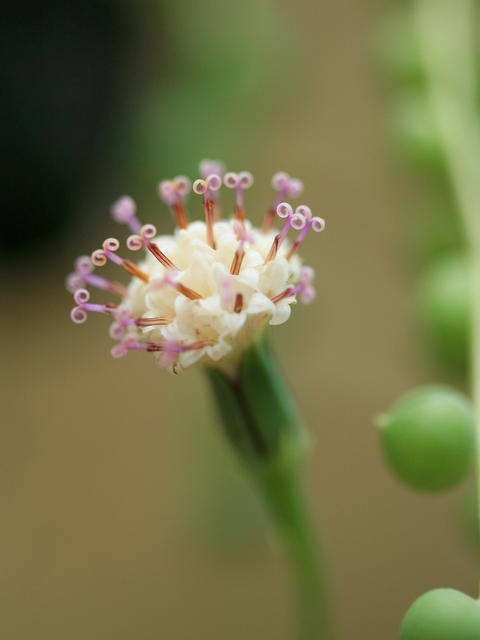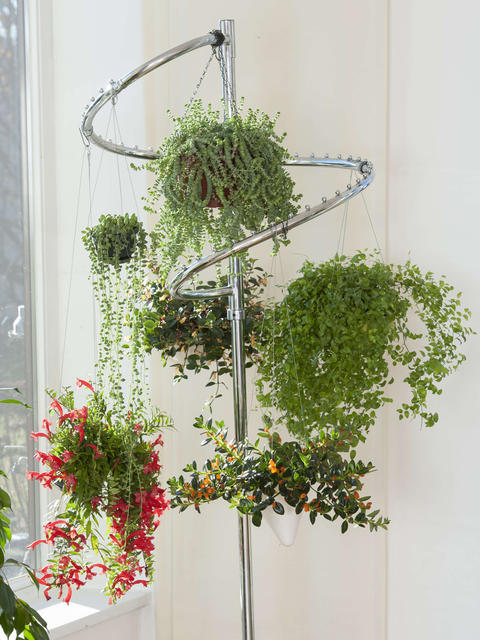String-of-pearls
String-of-pearls is decorated with long shoots and pearl-shaped leaves. You can find tips here about the correct way to care for Senecio rowleyanus.
Factsheet
- Growth type
-
- Succulent
- Growth height (from)
- from 30 cm to 100 cm
- Growth characteristics
-
- hanging
- overhanging
- carpet forming
- tight
- Flower color
-
- purple
- yellow
- pink
- white
- Flowering time (month)
-
- May to August
- Flower shape
-
- Flowercups
- small
- Flower characteristics
-
- lightly fragrant
- Leaf color
-
- green
- page format
-
- oirround
- roundish
- Sheet properties
-
- evergreen
- Light
-
- sunny to semi-shade
- Soil type
-
- gravelly to loamy
- Soil Moisture
-
- moderately dry to fresh
- ph value
-
- neutral to weakly acidic
- Lime compatibility
-
- sensitive to lime
- Nutrient requirements
-
- low in nutrients
- Decorative or utility value
-
- Leaf ornaments
- picturesque growth
- Use
-
- Interior greening
- Planters
- Winter garden
- Garden style
-
- Pot garden
The charming, somewhat odd looking String-of-pearls calls South Western Africa its home. There, it grows in a strictly limited geographical region in the Eastern and Western Cape provinces. It often thrives there in the shade of bushes or mountains which provide some protection from the strong sun. Senecio rowleyanus belong so the daisy (Asteraceae) family. The Senecio genus has more than 1,000 species, which include annual and perennial shrubs and woods, as well as some succulents, such as string of pearls.
The evergreen string of pearls is a creeping or overhanging succulent with delicate shoots which are quite thin and sometimes up to several feet long. They are a popular cultivated as an ornamental foliage plant in baskets thanks to their spectacular appearance, the ‘pearl strings’ can easily grow to 3 feet long. On the ground, they form veritable mats which do not grow taller than 4 inches. The roots tend to be flat and dense under the soil, the root system itself is more weakly developed - you should take this into consideration when choosing a pot: It’s better if the pot is rather wide.

The small, round leaves line up like a string of pearls, each with at miniscule stem. This novel appearance gives String-of-pearls its name. The individual leaves are 0.39 inches long and have a medium green color. They are alternating and tightly packed. A stripe can be seen on each ‘ball’, which runs lengthwise to the tip. The thick, fleshy leaves provide water storage for the houseplant.
As with all Senecio members, the leaves of string of pearls are also slightly poisonous. If they are swallowed by small children or pets, this can lead to vomiting or diarrhea. So it’s better if it is placed somewhere out of reach! Senecio rowleyanus is also sometimes available under the name Senecio herreianus. However, as the latter species tends to have longer leaves, it’s hardly possible to mix them up.
Small flowers appear in late spring and summer, which smell amazingly like Cinnamon and are also reminiscent of Daisies in appearance and color - white, pink, yellow and green. They certainly have a novel shape: Several green-white bracts sit directly under the flower head. The bracts grow to three quarters of their length and have a violet margin. The head is composed of up to 20 flowers. The petals grow together in a corolla tube and the curled back petal lobes are striking. The anthers stand out in a strong violet color, the pollen shines yellow.

It does not form fruit in indoor cultivation.
String-of-pearls prefers full sunlight and warmth, a south-west or south-east facing window is ideal. But if you don’t have one: It’s also satisfied with semi-shade, although then the growth is somewhat more reserved. In the warm times of year, the succulent can be brought outside to a protected, sunny to semi-shady spot. You should spare it the blazing midday sun, as well as an abrupt change from indoors to outdoors. It is essential to give it time to adjust to UV light. The temperature may fall to 54 degrees Fahrenheit in the winter. This reduction is also necessary for flowers to form. However, the temperature should not fall lower than 47 degrees Fahrenheit. It accepts low humidity without complaint.
Low-nutrient and readily draining cactus soil please Senecio rowleyanus best, it also does well in low-nutrient herb soil. You can also easily mix the substrate yourself.
The succulent foliage clearly shows that it doesn’t require much water. Ideally, use your finger to test whether the substrate has already dried to a depth of 0.79 inches before reaching for the watering can. However, when it is watered, the water should penetrate the entire root ball. If you like you can also water it via the plant pot saucer. There should never be water standing in the planter. Senecio rowleyanus doesn’t really mind if you use tap water or rain water, but it should not be extremely calciferous or cold water. In winter at low temperatures you should water it considerably less: At this time, string of pearls wants to be almost dry, it should be watered in short bursts.
Fertilizer is not necessary in the first year after purchase or after re-potting. Thereafter, a low dosage administration of cactus fertilizer every four or eight weeks in the summer is completely sufficient.
Is the pot fully rooted through? Then its time to put string of pearls in a larger container. It should also be flat. Re-potting is best done in the spring. Ideally, you should wear gloves when re-potting as the sap may cause skin irritation. String of pearls which need a new pot can also be divided at the same time: For this, cut the root ball in two to three pieces or carefully break it apart with your hands.
Just let them grow! The longer the shoots, the more spectacular String-of-pearls looks. If you have to, then prune overly long shoots by up to a third of their length.

Senecio rowleyanus ‘Variegata’ has light green and white patterned leaves. The variety does not grow as generously as the wild types and must have sunlight to develop the color contrast.
Nothing could be simpler than propagating String-of-pearls: Simply leave the cut shoots, which should have at least two to three leaves, to dry for two days and insert them into houseplant potting soil mixed with plenty of sand or cactus soil. If you place several cuttings into a plant container together, you can soon look forward to bushy, young plants. The first roots appear after just two weeks at temperatures around 68 degrees Fahrenheit.
All types of lice are bothersome to young shoots in the spring, otherwise, Senecio rowleyanus is very robust. Overwatering causes it the biggest problem as this leads to root rot.

